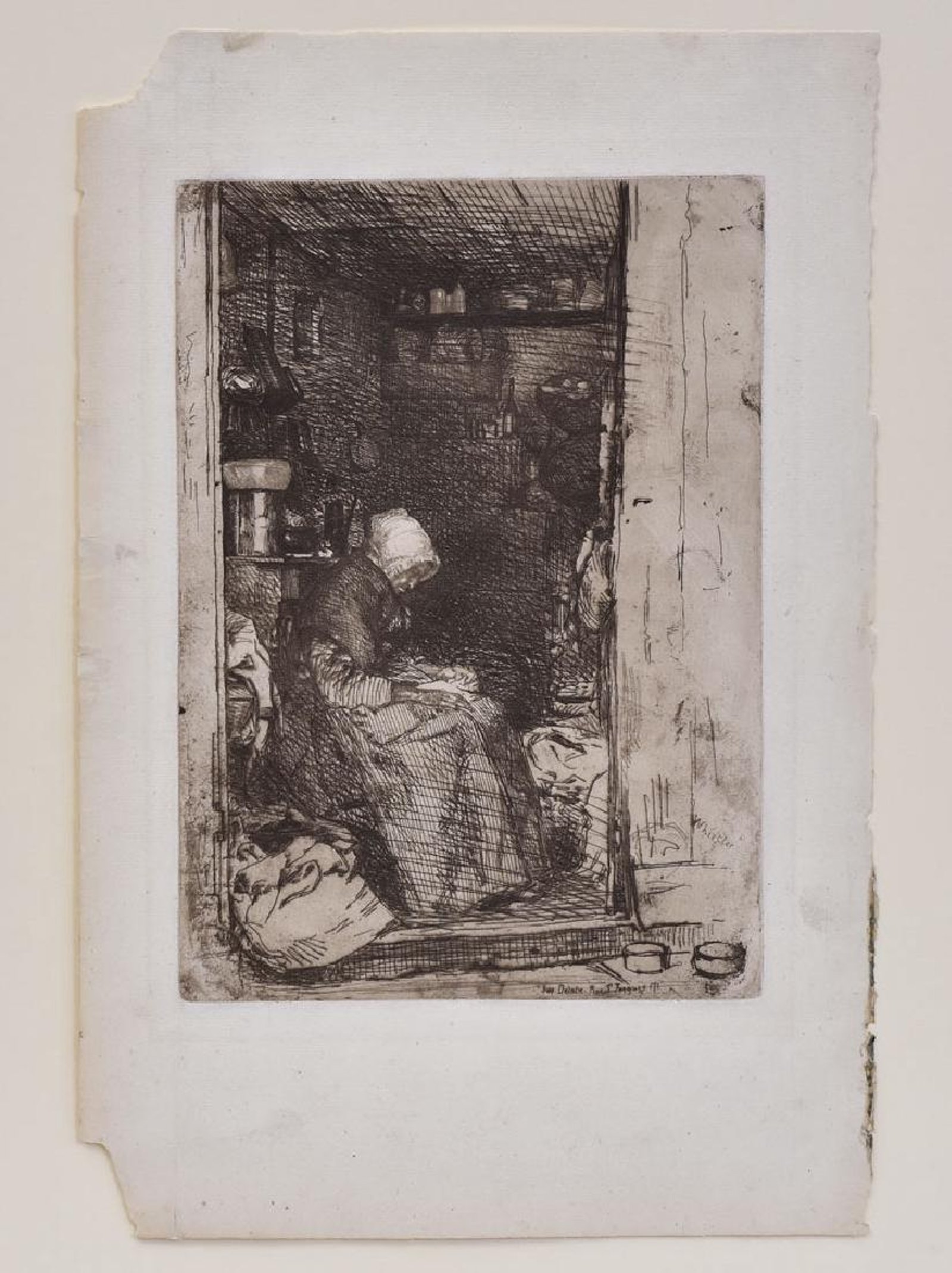
|
|
La Vieille
aux Loques
[The Old Rag Woman]
Kennedy 21, Mansfield,
21, Glasgow 27
etching with drypoint ,
1858, a splendid early trial proof impression, the third state (of 4), with Delatre's address lower
right, printed
in bistre with an elaborate veil of fine plate tone (meticulously wiped
locally, e.g., on the woman's bonnet and the fabric in her lap), on fine antique grayish
laid paper (without a
watermark), wide margins (though
somewhat irregular insofar as the upper and lower left corners are
missing,
having ostensibly been used to repair two short tears along the left
margin), several inky fingerprints in the margins, some tight localized
crimping and soiling along
the lower right margin (evidently from an old binding, which is also
attested by a series a regularly spaced stitching holes along the right
edge), with old hinges on the upper sheet edge, verso,
otherwise
in quite good
condition
Provenance:
the John
H. Wrenn collection (with his wetstamp verso, Lugt 1475) *
P. 209 x 148 mm., S. 306 x 200 mm.

|
Whistler
returned to Paris penniless from his late summer travels through Alsace and the Rhineland on 7 October 1858 with a number of copper plates and sketches, though he probably worked the plate for La Vieille aux Loques in the streets d'aprčs nature soon thereafter. This is
one of Whistler's best known early prints, and was published in his first album, Douze Eaux-fortes d'aprčs Nature (Twelve Etchings from Nature, known
as the French Set), which was
dedicated to his brother-in-law, Seymour Haden. The realization of this project was crucial in the artist's artistic development.
He began
proofing the plates in Auguste Delâtre's workshop.** While
Whistler had already gained some experience in the art, Delâtre guided
Whistler throughout the entire process, from the use of a
Dutch mordant and multiple biting to selective wiping, allowing rich
tonal effects. Whistler's etching and printing technique evolved
considerably, and this undertaking was to shape his
commitment to creative printmaking for decades.
The etching
style is accomplished, with a refined sense of line in rendering space,
object, contrast and texture: rapidly drawn or meticulously
appied,
sometimes dense, often spare, ranging from deeply contoured to extremely fine,
with deft cross-hatching in rendering a variety of values. That the plate was
extensively reworked is also evident in the foul biting and trace
fingerprints, showing the extent to which the ground was weakened by
repeated manipulations; Whistler apparently found these "accidents" quite
attractive, as no effort was made to alleviate them.
The published French Set comprised an edition of twenty impressions pulled
in Paris during November and an additional fifty impressions pulled a few weeks later in London, all on chine collé.
Given Whistler's exacting determination in completing it, however,
there are a number of proof impressions extant, of which our impression
is characteristic.
According to Katherine Lochnan:
Before
proving the plates, Delâtre probably dispatched Whistler to look for
pieces of antique paper on which to pull the experimental proofs.
According to the Pennells, by 1858 Whistler was "already hunting for
beautiful old paper, loitering at the boxes along the quais, tearing
out flyleaves from the fine old books he found there." ***
Our impression
is obviously one of these early proof impressions. The paper is
clearly not from the dual first edition, and its various "defects"
point to such a scavenged origin. Glasgow furthermore mentions several
impressions of the third state on anomalous papers, which seems also to show that Whistler devoted some time to proofing this print.****
In any case, given its popularity, the plate was
reprinted on several occasions in the fourth state, with Delâtre's address obliterated, and subsequently
cancelled. Glasgow cites 113 known impresssions.
* John
Henry Wrenn was an early collector
of Whistler's etchings in Chicago, and a large part of his fine
ollection was bequeathed to the Art Institute of Chicago in 1924.
(The Glasgow website mentions him forty times.
** Auguste
Delâtre had originally learned the art of etching from Charles Jacque, and in 1848
he set up shop with two presses on the rue Saint-Jacques. He
became a master of the medium, experimenting novel techniques, and was
instrumental in developing the Aquafortistes movement, which renewed artistic interest in original printmaking. (See Michel Melot, L'Estampe Impressioniste, Paris 1974.)
*** Katherine A. Lochnan, The Etchings of James McNeill Whistler, New Haven and London, 1984, pp. 49-59
**** Glasgow
catalogue: http://etchings.arts.gla.ac.uk/catalogue/search/ts_display/index.php?catno=K021&rs=&q=vieille&xml=pri


